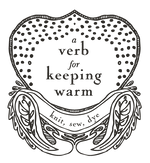
The typical pathway of creating an Alabama Chanin piece is to choose a sewing pattern, cut the fabric for the sewing pattern, stencil the fabric, layer the stenciled fabric over the a piece of non-stenciled fabric of the same size, stitch around the stenciled layers, cut the inside of the stenciled shape out, and then sew all the pattern pieces together. The last step is to add the neck and sleeve binding. Wait, the last step in completing an Alabama Chanin piece is to wear it...flaunt it? Yes, go for it, flaunt it.
When writing The Modern Natural Dyer, there were many experiments conducted, testing recipes, and fine-tuning projects. This process has provided us with an incredible library of naturally dyed yardage, yarn, and garments - like A.Chanin cardigans and tanks.


Some of the tanks have a bit of irregularity in the dyeing, as I have said before, there is always the option of embracing imperfection, and celebrating the movement of the hand, the aliveness of the natural dyeing process. Though, as an appreciator of the Alabama Chanin style of sewing, and one who finds the process of hand-stitching quite relaxing, I wondered what it would be like to add even more hand-work - to put two of the tanks together, and add the layers of stenciled paint, thread, and cut motifs, revealing another plane of naturally dyed color. I found this to be the perfect opportunity to try.
Both of the tanks I scoured, mordanted, and dipped into a wheat bran bath according to the directions for cellulose-based fibers in The Modern Natural Dyer.
Top Layer: Naturally dyed with weld in the darker of the two shades featured on p.98 of The Modern Natural Dyer
Bottom Layer: Naturally dyed with weld in the lighter of the two shades featured on p.98 of the The Modern Natural Dyer.
Once dyed, both tanks were dipped into a bath of iron-infused water. Though I used weld, there are many other dyes and colors you can choose for your own piece.
Onto stenciling...


Stencil: Anna's Garden
Paint: custom mixture of brown, black, and a hint of bronze
Thread: Taupe
TIPS
+ I added ironed a piece of freezer paper to the tank, for stability when stenciling, and so the fabric paint would not seep through to the other side.
+ When stenciling, I did not want to paint the binding on the neckline or on the armholes, so I taped over these areas.
+ If you do not own a spray gun to apply your fabric paint, using a square chunk of foam works better than a foam brush. The square piece of foam applies a thinner layer, more uniformly, so you will use less paint, and it will look more professional.
+ Paint the back first, so you can get used to the process. By the time you get to the front, you will be comfortable and confident.
+ I applied the above principle to stitching. I started at the top of the back. Once I felt like I had warmed up, I moved to the front. Always making sure my seams along the side were pinned and did not shift while stitching.



I always get really excited when stitching, and have a deep desire to peek at what the finished cloth will look like, so I snip away some of the motifs before completing all of my stitching. Plus, I find it easier on my hands if I balance stitching with cutting. As you can see, I am not quite done with my piece, but it is going really well, and figure I will be done by the end of April. It helps that the garments are already sewn, as once I am done stitching, it is ready to wear!
I know natural dyeing can be a labor of love, and can involve a process akin to learning a new language, but when I sit and stitch this piece, I marvel at the beauty and the infinite intricacies of color and depth provided by nature, and am in awe and gratitude for the extra time taken to apply naturally-dyed color to this piece.
As we round the corner, out of April into May, we also say goodbye to Alabama Chanin April, though, really at Verb, it is always Alabama Chanin April. Don't forget, we have Alabama Chanin stitch-ins every month. We stock a full range of colors in Alabama Chanin organic cotton jersey, a full range of sizes in A. Chanin tanks and cardigans, are always happy to order you a custom DIY kit, (where you get to pick the colors of jersey, the stencil, the pattern, the thread color, and the kit comes stenciled and the pattern pieces come cut, very exciting, I'm dreaming of this one right now), and always have on hand a collection of Alabama Chanin garments, hand-sewn, representing the collection of sewing patterns in the line of Alabama Chanin books, in an array of sizes, for you to try on before, to help orient you in size, style, and fit, before embarking on a new project.
The tank written about in this essay will be on display at Verb starting May 1st, so stop by and check it out. This month has been such a delight to work in tandem with Natalie and Alabama Chanin, I look forward to seeing your naturally-dyed x Alabama Chanin-style sewn pieces.
-- Kristine
P.S. In May, we are focusing on eco-printing, dye gardening, and the project from The Modern Natural Dyer titled Flowers at My Fingertips. Stay tuned! We have some exciting projects in store for you.
